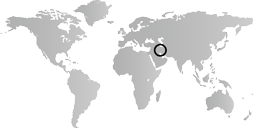The early years of the twentieth century witness an atmosphere of discontent and protest against the despotic rule of the Qajars and foreign intervention. Patriotic and nationalistic sentiments among the urban middle and religious classes lead to the creation of a constitutional movement and subsequently the Constitutional Revolution (1905–11). The British discover oil in 1908. The position of the last Qajar shahs becomes weaker and the military commander Reza Khan (1878–1944) topples the Qajar dynasty and establishes the Pahlavi dynasty in 1921. In the early twentieth century, artists such as Kamal al-Mulk (1852–1940) go to Europe and study old master and academic paintings, copying the originals by Raphael, Titian, and Rembrandt. They display a fascination with verisimilitude and realism, rather than contemporary artistic trends in Europe such as Impressionism. Upon their return, many artists found schools such as the Madrasa-i Sanayi-i Mustazrafa (Academy of Fine Arts).
During World War I, the country is occupied by British and Russian forces, but essentially remains neutral. Under Reza Shah’s reign, Iran begins to modernize and secularize and the central government reasserts its authority over the tribes and provinces. In 1941, after the British and Russian troops invade Iran and depose him, his son Muhammad Reza (1919–1980) is crowned shah of Iran. During his reign, Iran moves closer to the West, joining the Baghdad Pact and receiving military and economic aid from the United States. Muhammad Reza continues the modernizing efforts of his father. In the early 1960s, Iran initiates a program of economic, social, administrative, and land reforms known as the White Revolution. Modernization and economic growth proceed at an unprecedented rate, fueled by Iran’s vast petroleum reserves.
In the 1960s, the Islamic clergy headed by Ayatollah Ruhollah Khomeini (who had been exiled in 1964), becomes increasingly vociferous. Economic growth benefits only a very small group and succeeds in alienating the vast majority of the population, culminating in widespread religious protests in the 1970s. Religious and political opposition to the shah’s rule and programs—especially the much hated intelligence and security service, SAVAK—eventually consolidates into full-scale rebellion. The shah flees Iran in 1978 and in 1979 Ayatollah Khomeini returns from France to direct a revolution resulting in a theocratic republic guided by Islamic principles, overthrowing the shah’s government. In 1979, militant Iranian students seize the U.S. Embassy in Tehran and hold it until 1981. This is followed by an eight-year war with Iraq with countless losses and casualties. After 1997, the moderate Muhammad Khatami (born 1943) becomes president, which leads to a rift between a government seeking reform and moderate liberalization against an extremely conservative clergy. Iran’s poor economic conditions deepen and its association with terrorism continues to erode international support.
After the fall of the Qajars and a period of transition, artists initiate the modern art movement, often referred to as the Saqqakhana movement. The Tehran Museum of Contemporary Art is inaugurated in 1977. Contemporary artists in Iran produce art in modern as well as postmodern styles, while Iranian artists abroad keep up with current international and global trends as they grapple with issues of sociopolitical orientation, gender, religion, displacement, and cultural identity.


